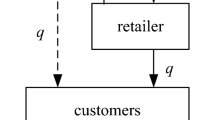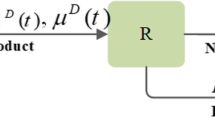Abstract
E-retailers have recently paid close attention to frugal innovation in their supply chains. However, there are few studies on frugal innovation considering the e-retailer’s platform value raised by the increase in the platform user scale. Motivated by industrial practice, we consider a supply chain consisting of an e-retailer and a manufacturer in the context of frugal innovation, where the platform value of the retailer is characterized by Metcalfe’s law. We use game models to investigate the frugal product price and optimal degree of frugality decisions for the centralized, decentralized, retailer-led revenue-sharing contract and bargaining revenue-sharing contract scenarios. Our results indicate that the bargaining revenue-sharing contract can improve the frugal degree of the development-intensive frugal product (DIFP), while the frugal degree of the marginal cost-intensive frugal product (MIFP) cannot be improved by cooperation in the supply chain. We then compare the supply chain profit, the platform value of the retailer and the profit of the manufacturer in different scenarios. The results show that the centralized scenario is the optimal scenario where the platform retailer implements vertical integration strategy. Otherwise, establishing strategic partnership through the bargaining revenue-sharing contract is suboptimal for both the platform retailer and the manufacturer.




Similar content being viewed by others
References
Abichandani Y (2012) Jugaad innovation: think frugal, be flexible, generate breakthrough growth. Eur J Train Dev 38(7):689–691
Agnihotri A (2015) Lowcost innovation in emerging markets. J Strateg Market 23(5):399–411
Anderson EG Jr, Parker GG, Tan B (2014) Platform performance investment in the presence of network externalities. Inf Syst Res 25(1):152–172
Bowman J (2019) Top Chinese e-commerce stocks to buy in 2019. https://finance.yahoo.com/news/top-chinese-e-commerce-stocks-163100177.html
Briscoe B, Odlyzko A, Tilly B (2006) Metcalfe law is wrong-communications networks increase in value as they add members-but by how much. IEEE Spectr 43(7):34–39
Chambers C, Kouvelis P, Semple J (2006) Quality-based competition, profitability, and variable costs. Manage Sci 52(12):1884–1895
Chen L, Peng J, Liu Z, Zhao R (2017) Pricing and effort decisions for a supply chain with uncertain information. Int J Prod Res 55(1):264–284
Gassmann O, Neumann L, Knapp O, Zollenkop M (2017) Frugal: simply a smart solution. Roland Berger Focus 8:1–32
Ghosh D, Shah J (2015) Supply chain analysis under green sensitive consumer demand and cost sharing contract. Int J Prod Econ 164:319–329
Giannoccaro I, Pontrandolfo P (2004) Supply chain coordination by revenue sharing contracts. Int J Prod Econ 89(2):131–139
Hänninen M, Mitronen L, Kwan S (2019) Multi-sided marketplaces and the transformation of retail a service systems perspective. J Retail Consum Serv 49:380–388
Hendler J, Golbeck J (2008) Metcalfe’s law, web 2.0, and the semantic web. Web Semant Sci Serv Agents World Wide Web 6(1):14–20
Hossain M (2017) Mapping the frugal innovation phenomenon. Soc Sci Electron Publ 51:199–208
Hossain M (2018) Frugal innovation: a review and research agenda. J Clean Prod 182:926–936
Hossain M, Simula H, Halme M (2016) Can frugal go global? Diffusion patterns of frugal innovations. Technol Soc 46:132–139
Hsiao L, Chen YJ (2014) Strategic motive for introducing internet channels in a supply chain. Prod Oper Manage 23(1):36–47
Huawei (2019) Huawei investment holdings co., ltd. 2018 annual report. https://www.huawei.com/cn/press-events/annual-report/2018
Jiang B, Jerath K, Srinivasan K (2011) Firm strategies in the ‘mid tail’ of platform-based retailing. Market Sci 30(5):757–775
Kahle HN, Dubiel A, Ernst H, Prabhu J (2013) The democratizing effects of frugal innovation. J Indian Bus Res
Khan R (2016) How frugal innovation promotes social sustainability. Sustainability 8(10):1034
Kim K, Chhajed D (2002) Product design with multiple quality-type attributes. Manage Sci 48(11):1502–1511
Kong X (2018) The top-selling 288 yuan sweeping robot sold by pdd were producted in this way... http://www.sohu.com/a/281593618_161795
Krishnan V, Gupta S (2001) Appropriateness and impact of platform-based product development. Manage Sci 47(1):52–68
Krishnan V, Zhu W (2006) Designing a family of development-intensive products. Manage Sci 52(6):813–825
Lacourbe P, Loch CH, Kavadias S (2010) Product positioning in a two-dimensional market space. Prod Oper Manage 18(3):315–332
Levänen J, Hossain M, Lyytinen T, Hyvärinen A, Numminen S, Halme M (2016) Implications of frugal innovations on sustainable development: evaluating water and energy innovations. Sustainability 8(1)
Linh CT, Hong Y (2009) Channel coordination through a revenue sharing contract in a two-period newsboy problem. Eur J Oper Res 198(3):822–829
Max M, Anne M, Rukhshana M (2016) Saving, scrimping, and...splurging? New insights into consumer behavior. https://www.mckinsey.com/industries/consumer-packaged-goods/our-insights/saving-scrimping-and-splurging-new-insights-into-consumer-behavior
Meagher K (2018) Cannibalizing the informal economy: frugal innovation and economic inclusion in Africa. Eur J Dev Res 30(1):17–33
Moon K, Bimpikis K, Mendelson H (2018) Randomized markdowns and online monitoring. Manage Sci 64(3):1271–1290
Moorthy KS, Png IPL (1992) Market segmentation, cannibalization, and the timing of product introductions. Manage Sci 38(3):345–359
Mussa M, Rosen S (1978) Monopoly and product quality. J Econ Theory 18(2):301–317
PDD (2019) Pinduoduo inc. 2018 annual report. http://investor.pinduoduo.com/financial-information/annual-reports
Perdikaki O, Peng DX, Heim GR (2015) Impact of customer traffic and service process outsourcing levels on e-retailer operational performance. Prod Oper Manage 24(11):1794–1811
Pisoni A, Michelini L, Martignoni G (2018) Frugal approach to innovation: state of the art and future perspectives. J Clean Prod 171:107–126
Prabhu J, Jain S (2015) Innovation and entrepreneurship in India: understanding Jugaad. Asia Pacific J Manage 32(4):843–868
Qian L (2011) Product price and performance level in one market or two separated markets under various cost structures and functions. Int J Prod Econ 131(2):505–518
Reed DP (2001) The law of the pack. Harvard Bus Rev 79(2):23–24
Rochet JC, Tirole J (2003) Platform competition in two-sided markets. J Eur Econ Assoc 1(4):990–1029
Rosca E, Arnold M, Bendul JC (2017) Business models for sustainable innovation—an empirical analysis of frugal products and services. J Clean Prod 162:S133–S145
Shapiro C, Carl S, Varian HR et al (1998) Information rules: a strategic guide to the network economy. Harvard Business Press, Boston
Sharma A, Iyer GR (2012) Resource-constrained product development: implications for green marketing and green supply chains. Ind Market Manage 41(4):599–608 (green marketing and its impact on supply chain)
Shen Y, Willems SP, Dai Y (2019) Channel selection and contracting in the presence of a retail platform. Prod Oper Manage 28(5):1173–1185
Shibin KT, Dubey R, Gunasekaran A, Luo Z, Papadopoulos T, Roubaud D (2018) Frugal innovation for supply chain sustainability in smes: multi-method research design. Prod Plan Control 29(11):908–927
Song H, Gao X (2018) Green supply chain game model and analysis under revenue-sharing contract. J Clean Prod 170:183–192
Wang F (2017) Demystifying netease’s strict selection of factories: How to achieve ‘good life is not so expensive’? https://www.yicai.com/news/5365721.html
Weyrauch T, Herstatt C (2017) What is frugal innovation? Three defining criteria. J Frugal Innov 2(1):1
Yao Z, Leung SC, Lai KK (2008) Manufacturer’s revenue-sharing contract and retail competition. Eur J Oper Res 186(2):637–651
Yu X (2019) The small-biu sweeper of suning, scheduled to only 999 yuan. http://biz.ifeng.com/a/20190403/45588066_0.shtml
Zeschky M, Widenmayer B, Gassmann O (2014) Organising for reverse innovation in western mncs: the role of frugal product innovation capabilities. Int J Technol Manage 64(2–4):255–275
Zhang P, Xiong Y, Xiong Z (2015) Coordination of a dual-channel supply chain after demand or production cost disruptions. Int J Prod Res 53(10):3141–3160
Zhu W, He Y (2017) Green product design in supply chains under competition. Eur J Oper Res 258(1):165–180
Acknowledgements
The authors are grateful to the associate editor and the anonymous referees for their thorough and constructive comments. This research is supported in part by the Graduate Innovative Research Projects of Chongqing Technology and Business University (yjscxx2019-101-90).
Author information
Authors and Affiliations
Corresponding author
Ethics declarations
Conflict of interest
The authors declare that they have no conflict of interest.
Additional information
Communicated by V. Loia.
Publisher's Note
Springer Nature remains neutral with regard to jurisdictional claims in published maps and institutional affiliations.
Appendices
A Proof of Proposition 2
As for the DIFP, we first compare the optimal degree of frugality under revenue-sharing contract and centralized model. Note that the condition \(a, \beta \ne 0, 4r(1-\lambda ^2)-\beta ^2\ne 0\) and \(8r(1-\lambda ^2)-\beta ^2\ne 0\) implies that \(a, \beta \ne 0, 4r-\frac{\beta ^2}{1-\lambda ^2}\ne 0\) and \(8r-\frac{\beta ^2}{1-\lambda ^2}\ne 0\). Since \(\frac{a\beta }{4r(1-\lambda ^2)-\beta ^2}>\frac{a\beta }{2[4r(1-\lambda ^2)-\beta ^2]}=\frac{a\beta }{8r(1-\lambda ^2)-2\beta ^2}>\frac{a\beta }{8r(1-\lambda ^2)-\beta ^2}\), we can obtain that \(\alpha (B)>\alpha (RS)>\alpha (D)\).
Then, we should prove that \(\alpha (B)>\alpha (BS)>\alpha (RS)\). Since \(\frac{a\beta }{4r(1-\lambda ^2)-\beta ^2}>\frac{2}{3}\cdot \frac{a\beta }{4r(1-\lambda ^2)-\beta ^2}=\frac{2a\beta }{12r(1-\lambda ^2)-3\beta ^2}>\frac{1}{2}\cdot \frac{a\beta }{4r(1-\lambda ^2)-\beta ^2}= \frac{a\beta }{8r(1-\lambda ^2)-2\beta ^2}\), we know that \(\alpha (B)>\alpha (BS)>\alpha (RS)\). Thus, \(\alpha (B)>\alpha (BS)>\alpha (RS)>\alpha (D)\) when \(a, \beta \ne 0, 4r-\frac{\beta ^2}{1-\lambda ^2}\ne 0\) and \(8r-\frac{\beta ^2}{1-\lambda ^2}\ne 0\).
B Proof of Proposition 4
We first compare the total supply chain profit of the MIFP under different scenarios. From Table 2, it is easy to say that \(\frac{(\beta ^2+4ak)^2}{64k^2(1-\lambda ^2)}>\frac{(\beta ^2+4ak)^2}{72k^2(1-\lambda ^2)}>\frac{3(\beta ^2+4ak)^2}{256k^2(1-\lambda ^2)}\). Since \(\varPi _C^m(D)=\varPi _C^m(RS)\), it can be derived that \(\varPi _C^m(B)>\varPi _C^m(BS)>\varPi _C^m(RS)=\varPi _C^m(D)\). Note that the condition is \(k\ne 0\).
For the DIFP, we first compare the total supply chain profit under centralized model, bargaining revenue-sharing contract and revenue-sharing contract. Since \(\frac{a^r}{4r(1-\lambda ^2)-\beta ^2}>\frac{8a^r}{9[4r(1-\lambda ^2)-\beta ^2]}=\frac{8a^2r}{36r(1-\lambda ^2)-9\beta ^2}>\frac{3a^2r}{4[4r(1-\lambda ^2)-\beta ^2]}=\frac{3a^2r}{16r(1-\lambda ^2)-4\beta ^2}\), it is easy to see that \(\varPi _C^d(B)>\varPi _C^d(BS)>\varPi _C^d(RS)\). The conditions of establishment are \(a, r, \beta \ne 0\) and \(\frac{1}{1-\lambda ^2}\ne \frac{4r}{\beta ^2}\). Next, we compare the total supply chain profit between decentralized model and revenue-sharing contract. It can be obtained that \(\scriptstyle {\frac{\varPi _C^d(D)}{\varPi _C^d(RS)}=\frac{192r^2(1-\lambda ^2)^2-48r(1-\lambda ^2)\beta ^2-16r(1-\lambda ^2)\beta ^2+4\beta ^4}{192r^2(1-\lambda ^2)^2-48r(1-\lambda ^2)\beta ^2+3\beta ^4}}\). When \(\frac{1}{1-\lambda ^2}\le 16r\), \(\varPi _C^d(B)>\varPi _C^d(BS)>\varPi _C^d(RS)\ge \varPi _C^d(D)\). When \(\frac{1}{1-\lambda ^2}>16r\), \(\varPi _C^d(RS)<\varPi _C^d(D)\). We continue to compare the total supply chain profit under the decentralized model and bargaining revenue-sharing contract. Similarly, we can obtain that when \(16r<\frac{1}{1-\lambda ^2}\le \frac{20r}{\beta ^2}\), the order is \(\varPi _C^d(B)>\varPi _C^d(BS)\ge \varPi _C^d(D)>\varPi _C^d(RS)\); when \(\frac{1}{1-\lambda ^2}>\frac{20r}{\beta ^2}\), the order is \(\varPi _C^d(B)>\varPi _C^d(D)>\varPi _C^d(BS)>\varPi _C^d(RS)\), while in practice \(\lambda \in [0,0.5]\Leftrightarrow \frac{1}{1-\lambda ^2}<1.3\), \(\frac{1}{1-\lambda ^2}\) will not be larger than 16r. In summary, \(\varPi _C^d(B)>\varPi _C^d(BS)>\varPi _C^d(RS)\ge \varPi _C^d(D)\).
C Proof of Proposition 5
When the centralized scenario cannot be realized, the bargaining revenue-sharing contract is the optimal contract to coordinate the supply chain. Both the manufacturer and the e-retailer have incentive to choose this contract. For the manufacturer of the MIFP, since \(\frac{(\beta ^2+4ak)^2}{128k^2(1-\lambda ^2)}<\frac{(\beta ^2+4ak)^2}{96k^2(1-\lambda ^2)}\) (\(k\ne 0\)), \(\varPi _M^m(BS)>\varPi _M^m(D)=\varPi _M^m(RS)\). The profit of the manufacturer under bargaining revenue-sharing contract is larger than other scenarios. For the e-retailer selling the MIFP on the platform, since \(\frac{\lambda ^2(\beta ^2+4ak)^2}{64k^2(1-\lambda ^2)^2}>\frac{\lambda ^2(\beta ^2+4ak)^2}{144k^2(1-\lambda ^2)^2}>\frac{\lambda ^2(\beta ^2+4ak)^2}{256k^2(1-\lambda ^2)^2}\), the platform value added under centralized model is larger than other scenarios. Moreover, the platform value added under bargaining revenue-sharing contract is the second largest. Therefore, if the centralized model cannot be achieved, the bargaining revenue-sharing contract is the optimal contract both for the manufacturer and the e-retailer.
For the manufacturer of the DIFP, since \(\frac{2a^2r}{12r(1-\lambda ^2)-3\beta ^2}>\frac{a^2r}{8r(1-\lambda ^2)-2\beta ^2}>\frac{a^2r}{8r(1-\lambda ^2)-\beta ^2}\) (\(r\ne 0\)), \(\varPi _M^d(BS)>\varPi _M^d(RS)>\varPi _M^d(D)\). The profit of the manufacturer under bargaining revenue-sharing contract is larger than other scenarios. For the e-retailer selling the DIFP, since \(\frac{4a^2r^2\lambda ^2}{(4r-4r\lambda ^2-\beta ^2)^2}>\frac{16a^2r^2\lambda ^2}{9(4r-4r\lambda ^2-\beta ^2)^2}>\frac{a^2r^2\lambda ^2}{(4r-4r\lambda ^2-\beta ^2)^2}\), \(V^d(B)>V^d(BS)>V^d(RS)\), where we use V to denote the platform value added. The platform value added under bargaining revenue-sharing contract is larger than revenue-sharing contract. We then compare \(V^d(D)\) and \(V^d(RS)\) by using the equation \(\frac{V^d(D)}{V^d(RS)}=\frac{64r^2(1-\lambda ^2)^2-32r(1-\lambda ^2)\beta ^2+4\beta ^4}{64r^2(1-\lambda ^2)^2-16r(1-\lambda ^2)\beta ^2+\beta ^4}\). It is easy to see that when \(3\beta ^4-16r(1-\lambda ^2)\beta ^2>0\), \(V^d(D)>V^d(RS)\). By algebra, we have \(V^d(D)>V^d(RS)\Leftrightarrow 3\beta ^2>16r(1-\lambda ^2)\Leftrightarrow \frac{1}{1-\lambda ^2}>\frac{16r}{3\beta ^2}\), where \(\beta \ne 0\). The parameter \(\lambda \) represents the user conversion rate of the platform e-retailer, and \(\lambda \in [0,0.5]\) in practice usually. Hence, \(\frac{1}{1-\lambda ^2}<1.3\). The parameters r and \(\beta \) reflect the fixed cost coefficient of the DIFP and the consumer sensitivity with respect to the frugal level \(\alpha \), respectively. r is much larger than \(\beta \) in practice. In summary, what is in line with the actual situation is that \(\frac{1}{1-\lambda ^2}<\frac{16r}{3\beta ^2}\). Therefore, \(\frac{1}{1-\lambda ^2}<\frac{16r}{3\beta ^2}\Leftrightarrow V^d(D)<V^d(RS)\). It can be obtained that \(V^d(B)>V^d(BS)>V^d(RS)>V^d(D)\).
Rights and permissions
About this article
Cite this article
Li, Z., Zhang, H. & Gao, R. Frugal innovation in supply chain cooperation considering e-retailer’s platform value. Soft Comput 24, 15373–15387 (2020). https://doi.org/10.1007/s00500-020-04872-1
Published:
Issue Date:
DOI: https://doi.org/10.1007/s00500-020-04872-1




